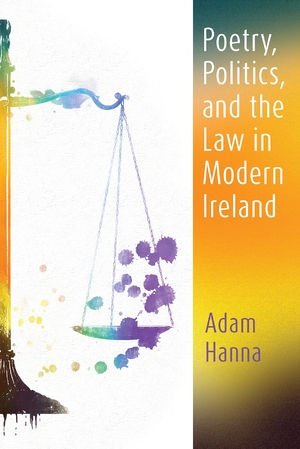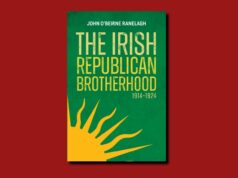
Poetry, Politics, and the Law in Modern Ireland|Adam Hanna| Syracuse University Press|ISBN 9780815637660|hb $75.00
Rigour and openness—Poetry, Politics, and the Law in Modern Ireland, by Adam Hanna (Syracuse University Press)
by Dr Karl O’Hanlon
Adam Hanna’s monograph Poetry, Politics, and the Law in Modern Ireland heralds a new field in the study of Irish poetry: in its gripping exploration of the intimate contradictions posed by the poet’s role as unacknowledged legislator, and its judicious, well-weighed close readings, it blazes a trail within Irish legal humanities, establishing a watertight case for future enquiry in this area.
The book opens with a paradigm test case, a prose poem draft by Seamus Heaney later developed into ‘The Unacknowledged Legislator’s Dream’ (published in North). From Heaney’s acute second thoughts about possessive pronouns and word choice, Hanna elaborates one of the central theses of the book: that the relationship of poetry to law and politics is one vexed by complex, at times countervailing pressures.
In the Irish case, links between law, poetry, and authority are informed by centuries of bardic precedent, as Hanna explores in the introduction, a relationship sharpened by a brutal history of dispossession and colonisation. At times, the vatic role—speaking for and representing the dispossessed, or righting/writing the wrongs of law and polity—comes into direct conflict with the poet’s responsibility to their art: Hanna cites Patrick Kavanagh’s refusal in ‘The Hero’ to become a martyr for ‘virtue or truth’ (14). These integral fault-lines go as far back as Plato and his banishment of the poet-liars from The Republic.
W.B Yeats
The first chapter considers W.B. Yeats’s role as legislator and state-builder in the new Irish Free State, and how the poems of the revolutionary period preceding it exhibit an increasing strain in Yeats’s faith in the civil legal system. Intriguingly, Hanna gestures towards a shrewd political operator who suspected that ‘poetry and legislatures may not mix’ (46).
The chapter provides compelling insights into the famous vacillations or paradoxes of Yeats’s artistic and political stances, with careful attention to form (the ‘dissociative’ perspective of Yeats’s ‘Among School Children’, 48) wrestling with Yeats’s daemonically-ambivalent body of work.
Austin Clarke
Chapter Two concerns Austin Clarke’s raids on the mythological paraphernalia of the Celto-Romanesque period to indict the legislative failings of conservative clerisy in the Free State. Divorce, rather than exclusively a matter for Anglo-Irish or Protestant rights of conscience, appears in Clarke’s 1920s poetry as a pre-Christian legal right fallen into desuetude.
Hanna persuasively argues that Clarke, a central figure of ridicule in Samuel Beckett’s attacks on literary conservatism, was among the earliest writers disillusioned with the state’s official mythologies. This iconic note sounds in Clarke’s ‘Penal Law’, with its opening imperative ‘Burn Ovid with the rest’ read by Hanna as Clarke’sreductio ad absurdum of the state’s repressive censorship.
Rhoda Coghill
Chapter Three focuses on Rhoda Coghill, a poet and composer whose work has been recovered in pioneering feminist scholarship (particularly recent work by Kathy D’Arcy).
Hanna probes Coghill’s preoccupations with ‘criminality, subterfuge, violence, and female guilt’, with stunning readings of poems such as ‘The Robin’ from Coghill’s 1948 collection The Bright Hillside, in which the bird (a Christ-cipher) drives its song through a solemn mass in a nearby church, ‘a light counterpoint’ that renders the mass ‘bubbles, loops and freaks and gyres’ (78). Not for nothing was the poem rejected by The Capuchin Annual!
Essays and interviews
Chapter Four builds on essays and interviews by Hanna in Poetry Ireland Review and PN Review, considering the relationship of T.K. Whitaker’s New Ireland and the new poetics in the mid-Sixties of poet and civil servant, Thomas Kinsella.
The chapter refreshingly adds to ubiquitous analyses of ‘Nightwalker’ with an examination of Kinsella’s early poetry, which, unlike that major poem reckoning directly with Whitaker’s Programme for Economic Expansion, were written while Kinsella was still a civil servant: ‘Another September’, ‘A Country Walk’ mingle ‘Virgilian language with the colours of the Republic’ (95).
Seamus Heaney
Chapter Five, on the exemplary civic imagination of Seamus Heaney, contains much of the heft and ruminative power of the monograph. Setting Heaney’s version of Antigone, The Burial at Thebes, against competing visions from the reactionary defence of Creon in the journalism of Conor Cruise O’Brien, Hanna posits the idea of ‘unwritten laws’ as Heaney’s defence against legal positivism, and elicits the roots of this humanism in agrarian protest and dissidence of the eighteenth century onward.
As Hanna judiciously observes in a winning phrase, ‘it is typical of Heaney’s work that its meliorative, peaceable ideas are inextricable from more radical… ones’ (104). In passages on Heaney’s early poetry in North, through to the versions of a late poem like ‘The High Wood’ (which characteristically retracts a politically-risky verb), Hanna’s chapter is required reading for those intent on coming to terms with the redress Heaney’s poetry affords.
Durcan and Meehan
Chapter Six takes us into the rollicking pyrotechnics of Paul Durcan and the courageous frankness of Paula Meehan. Meehan’s ‘The Statue of the Virgin at Granard Speaks’ is read beyond its immediate context, the traumatic death in childbirth of teenager Ann Lovett in 1984 before the shrine. Knowledge and silence are the poem’s concerns, and these are distinctly Irish concerns with far-reaching implications.
Hanna draws out Meehan’s resistance to the iconography of the Eternal Feminine, her fierce rejection of this enforced silence in place of ‘the bleeding, emotional, living reality’ (Meehan, cited 136). Durcan’s poetry is read against contexts as various as discriminatory homophobic legislation, the Eighth Amendment, the Divorce Referendum, and his judge-father’s shadowy understanding of the law of historical consequence: the tit-for-tat law of an eye for an eye that exists adjacent to, and outside the partial and capricious protections of the legal system.
Recent poetry
The final chapter considers recent poetry contending the state and its legislative and judicial apparatus. Elaine Feeney, Miriam Gamble, and Doireann Ní Ghíofra are read alongside Julie Morrissy’s poetry of montage and collage in ‘Civil Regulations Amendment Act 1956: Retirement of Women Civil Servants on Marriage’, which Hanna traces to the influence of docu-poets such as M. NourbeSe Philip.
Hanna concludes with an investigation of work by Kimberly Campanello, another powerful presence in contemporary Irish poetry whose MOTHERBABYHOME on the Tuam Scandal is read as a counter-inquiry in an august line from Kinsella’s Butcher’s Dozen onward: not replacing the legal system, but rendering visible its narrative erasures.
This accessible book contends with incredibly difficult, dark and disputed matter at the heart of civil society and the politics of Irish statehood. It does so with flair: there are bravura stretches, especially in Hanna’s close readings, but it is in its rigour and openness to ambivalence that the book rests its case.












